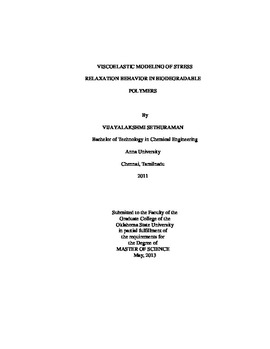| dc.description.abstract | Regenerating tissues using biodegradable structures onto which cells attach, populate, and synthesize new tissue or a whole organ has become more essential due to the scarcity in donor transplants. The biodegradable structures from various animal tissues such as skin, bladder, fat and intestine have seen clinical usage due to the advantage of premade architecture, which is conducive for tissue regeneration. However, manipulating these architectures to grow other tissues has shown many obstacles. Hence, synthesizing matrixes of both synthetic and natural polymers should possess bioactivity along with high porous structures to aid cell in-growth and mechanical strength to withstand the stresses and strains in the body. Biological tissues exhibit viscous (like fluids) and elastic (like solids) behavior, hence, prepared materials should have similar characteristics.Previously we have reported on the stress relaxation characteristics of poly-lactic-co-glycolic acid (PLGA) films [1], polycaprolactone (PCL) films [2] and chitosan, chitosan-gelatin porous structures [3] formed by freeze-drying. We have also modeled some of the behavior using quasi-linear viscoelastic model and pseudo component models. The objective of this study was to evaluate and model the effect of processing scaffolds in viscoelastic behavior and also to compare the relaxation characteristics of polymers as different structures (scaffolds and films). For this purpose, we prepared PCL scaffolds by salt leaching technique and electrospun technique; chitosan, chitosan-gelatin films by air drying technique. First, uniaxial tensile properties were evaluated under physiological conditions (hydrated in phosphate buffered saline at 37 C). From the estimated break strain, the limit of strain per ramp was calculated and stretched. The ramp-and-hold type of stress relaxation test was performed for five successive stages.We developed two models using (i) 5- parameter model (containing two components with a hyper-elastic spring and suitable pseudo component) and (ii) 8- parameter model (containing three components with a hyper-elastic spring and two suitable pseudo components) in Visual Basic Applications accessed through MS Excel. The models were used to fit the experimental stress-relaxation data and parameters were obtained to understand the influence of porous architecture. To validate the utility of the models, obtained parameters were used to predict cyclic behaviors, which were compared independently with the cyclical experimental results. These results showed the model could be used to predict the cyclical behavior under the tested strain rates. | |
